#HMAS SHROPSHIRE
Explore tagged Tumblr posts
Text
Royal Australian Navy Heavy Cruiser HMAS Shropshire


Commissioned into the British Royal Navy on 24 September 1929, HMS Shropshire was a County-class heavy cruiser. Following the loss of her sister ship HMAS Canberra, she was transferred to the Royal Australian Navy on 20 April 1943. HMAS Shropshire remained in RAN service until 1949 and was sold for scrap in 1954.
More photos here.
#HMASShropshire#heavyCruiser#cruiser#RAN#RoyalAustralianNavy#navy#naval#maritime#warfare#military#WorldWarTwo#SecondWorldWar
0 notes
Text
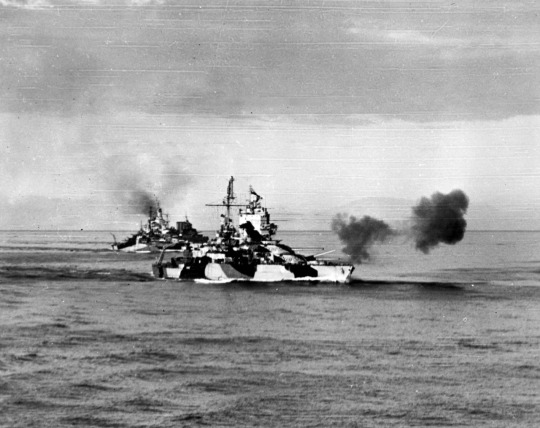
USS MISSISSIPPI (BB-41) bombarding Luzon, during the Lingayen operation. She is followed by USS WEST VIRGINIA (BB-48) and HMAS SHROPSHIRE.
Note: MISSISSIPPI is painted in camouflage Measure 32, Design 6D.
Photographed from USS NEW MEXICO (BB-40) on January 8, 1945.
U.S. Naval History and Heritage Command: 80-G-301229
#USS MISSISSIPPI (BB-41)#USS MISSISSIPPI#New Mexico Class#USS WEST VIRGINIA (BB-48)#USS WEST VIRGINIA#Colorado Class#Dreadnought#Battleship#Warship#Ship#HMAS SHROPSHIRE#United States Navy#U.S. Navy#US Navy#USN#Navy#Royal Australian Navy#RAN#World War II#World War 2#WWII#WW2#WWII History#Invasion of Lingayen Gulf#Lingayen Gulf#Luzon#Philippines#Philippines campaign#January#1945
37 notes
·
View notes
Photo

“USS Mississippi (BB-41) bombarding Luzon, during the Lingayen operation, 8 January 1945. She is followed by USS West Virginia (BB-48) and HMAS Shropshire. Photographed from USS New Mexico (BB-40). Mississippi is painted in camouflage Measure 32, Design 6D.”
(NHHC: 80-G-301229)
#Military#History#USS Mississippi#USS West Virginia#Battleship#HMAS Shropshire#Heavy cruiser#United States Navy#US Navy#Royal Australian Navy#WWII#WW2#Pacific War#World War II
163 notes
·
View notes
Text
[ID: screenshots of 9 tweets by Molly Hodgdon @/Manglewood with black and white photos of navy cats:
1 “Good news: I have gathered a bunch of photos of naval ship cats in tiny hammocks. Here are sailors of the HMS Hermione in 1941 surrounding their sleeping cat, Convoy.” Photo: a calico cat sleeps in a hammock strung between two poles, while a crowd of men stand watching and one man sits behind the hammock.
2 “Saipan of the USS New Mexico.” Photo: A naval officer leans in to touch the foot of a tortoiseshell cat lounging in a hammock hung under a shelf.
3 “Thomas of the HMS Shropshire got a whole bedtime series.” Photo: three newspaper clippings showing a tabby cat curled up in a hammock. In the last two photos he is partly under a blanket. Headline: “The Ship’s Cat: An Entertaining Series of Pictures taken Aboard H.M.S. Shropshire”. Caption 1: “‘What about a blanket?’ The ship’s cat, in spite of his winter coat, feels slightly chilly.” Caption 2: “‘That’s better.’ Well wrapped up by an obliging friend and ready for a night’s sound sleep.” Caption 3: “‘Rocked in the cradle of the deep.’ Thomas sleeps soundly in his comfortable hammock, dreaming, no doubt, of his wives in Malta, Gib., and Portsmouth.”
4 “Kitten on HMAS Kanimbla at some point during WW2.” Photo: a young tabby kitten sleeps stretched out in a hammock, with one paw covering its nose.
5 “Kitten mascot of the aircraft carrier HMS Eagle, circa 1945.” Photo: a tabby cat looks up while lounging on pillows in a hammock.
6 “Crew member of HMS Warspite asleep with the ship’s mascot kitten in its hammock, 1944.” Photo: a young kitten lies in a hammock and looks alert, while a naval officer sleeps on the bench below.
7 “Kitten aboard HMS Achilles, circa 1939.” Photo: a black cat wearing a mini naval hat and jacket lies in a hammock on the ship’s deck.
8 “Two potatoes in a sling. HMAS Nizam, 1941.” Photo: two black and white cats lie tail to tail in a hammock, while a naval officer stands just behind them looking at the camera.
9 “Tiny friend go HMCS Iroquois, 1944.” Photo: a black and white cat looks up from its hammock, while a man sleeps below with his arms crossed. End ID]
there are many benefits to being a Naval Salior
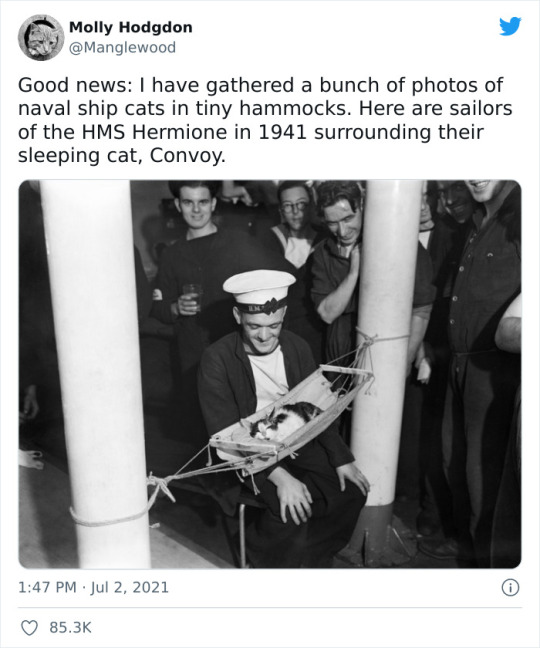
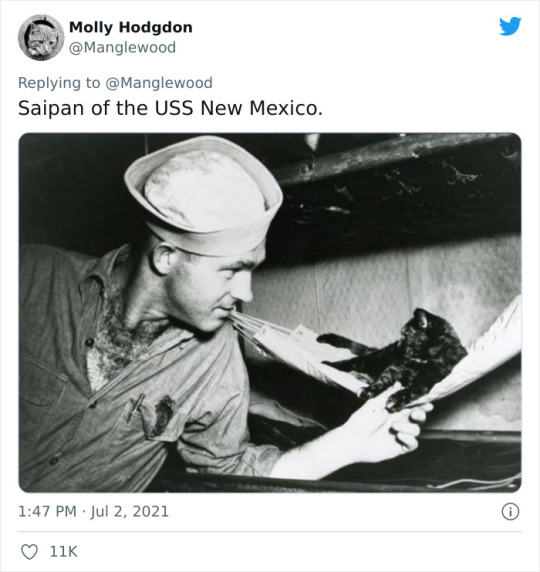
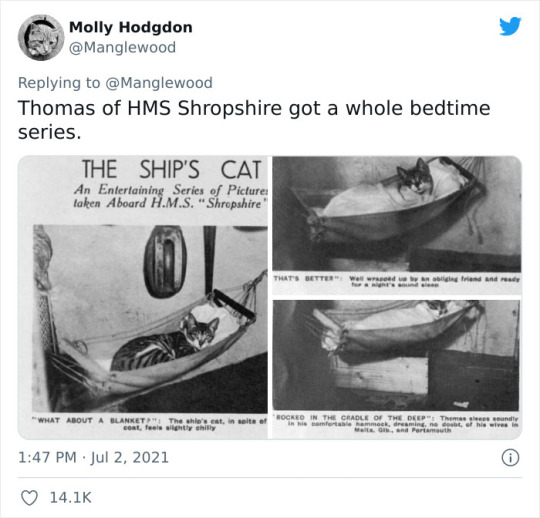


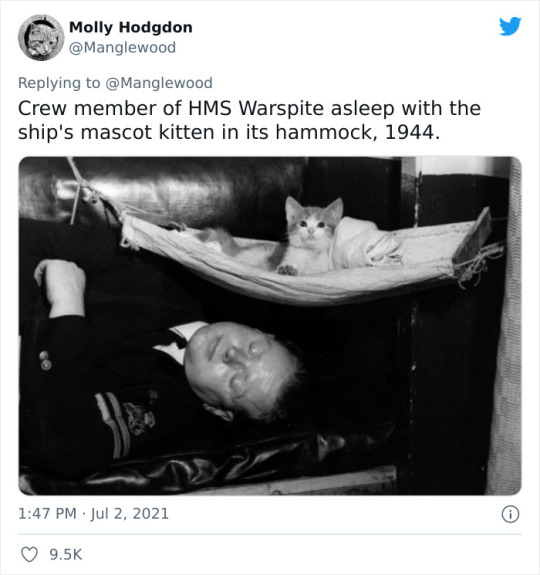
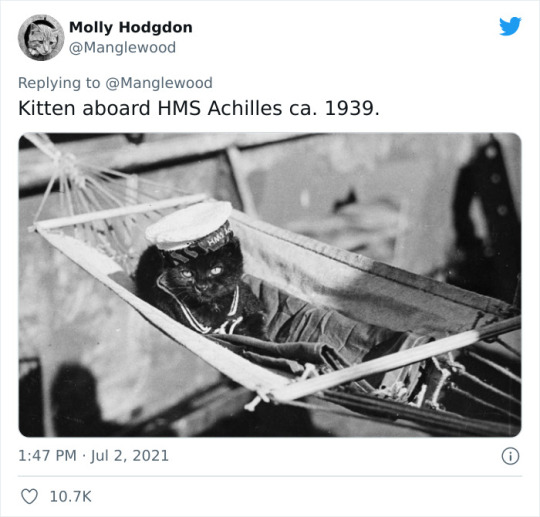
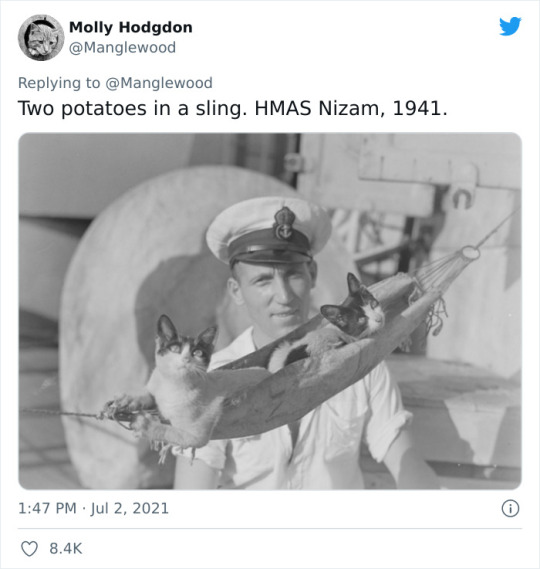
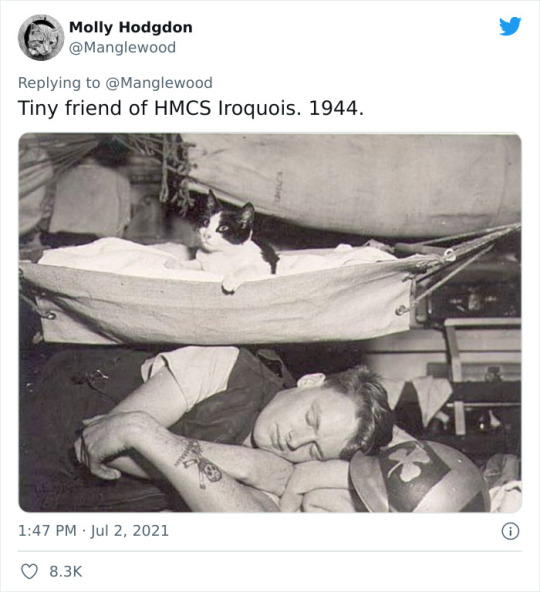
it used to be pretty common for there to be cats on boats. they'd take care of any rodents who would chew on ropes or wires and spread diseases. sailors were also superstitious and believed that having a cat aboard would bring good luck! this belief passed on to their wives, who kept cats - especially black ones who were believed to be extra lucky - at home in order to keep their husbands safe when at sea.
another popular superstition? that if a cat came aboard it was a sign of luck, but if it only boarded halfway and then left, it was a sign of bad luck.
most ship's cats are only found in modern times on private vessels, but they have roots going back to early history. one such example is the Vikings, who took cats with them on expeditions.
Sources: Ship's Cats, @Manglewood
52K notes
·
View notes
Photo

Eight-barrel 2-pounder anti-aircraft pom-pom mounting on the heavy cruiser HMAS Shropshire, 1944 [699×1000] Check this blog!
2 notes
·
View notes
Text
Battle of Surigao Strait: Veterans recall horrors of World War II
#PHnews: Battle of Surigao Strait: Veterans recall horrors of World War II
REVISITING THE PAST. Retired Royal Admiral Guy Richmond Griffiths (left), 97, and David Henry Mattiskie, 96, (center) join the three-day commemoration of the 75th anniversary of the historic Battle of Surigao Strait, from October 23 to 25, 2019 in Surigao City. A floral offering at sea was placed near the area where the battle took place. (Photo courtesy of DOT-13 Information Office)
SURIGAO CITY -- Retired Royal Admiral Guy Richmond Griffiths and David Henry Mattiskie, both part of the Australian Navy when the World War II broke out, arrived in town to join the three-day commemoration of the 75th anniversary of the historic Battle of Surigao Strait from October 23 to 25, in this city. The Australians were allied with the United States and the Philippines that fought the Imperial Japanese forces. Griffiths, now 97 years old and Mattiskie, 96, flew back to the Philippines to join the event. “War is a dreadful part of civilization,” Griffiths told PNA in an interview as he expressed gratitude to those who sacrificed their lives for the peace that nations and their citizens are enjoying nowadays. “You come from peace and suddenly, somebody wants to create war,” Griffiths recalled the time when Japan declared war against the US and bombed Pearl Harbor and parts of the Philippines, particularly Davao. He said war remains a horrible experience for humans as millions die and countries enormously devastated. Griffiths said that at his age, he could not still understand what anyone would get from the death of millions of people "and the colossal devastations of countries and communities." “My question is: what’s been achieved from these aggressions? Countries have to rebuild. Fathers, sons, daughters, and families were killed. It’s dreadful,” Griffiths asked. He said the key to maintaining peace in the world today is mutual understanding and good relationships among nations. “We need to talk to each other and maintain good relationships and understanding between people, rather than aggressive,” Griffiths said. Early morning battle Griffiths can still recall where he was positioned during the historic Battle of Surigao Strait that started the early morning of October 25, 1944. He was on board the HMAS Shropshire, an Australian gun cruiser serving as Assistant Control Officer. “On the morning of the 25th of October, we started firing just before 4 o'clock or at 3:56 in the morning,” Griffiths told PNA in an interview. “When we were firing, I was the Assistant Control Officer. The firing was from down below but I could see all the firing that was going on,” he added. Since it was still dark, Griffiths said all he could see from the distance are fires in Japanese ships that were badly-hit by torpedoes. “One exploded. I could only see the explosions, the fire,” he said. Mattiskie said he was at the bridge when the firing started. “We were firing at 4 in the morning. I was on board the HMAS Shropshire. I was at the bridge at that time listening to what was happening. I knew that the Americans were also firing their torpedoes towards the enemy ships,” he said. Griffiths said the firing stopped at past 4 a.m. “and that was the end of the battle.” Six Japanese warships, under the command of Vice-Admiral Shoji Nishimura, were destroyed during the Battle of Surigao Strait: Fuso, Yamagumo, Asagumo, Yamashiro, Michishio, and Mogami. Nishimura was among the more than 4,000 Japanese sailors who perished during the battle. The historical account said 39 American sailors were also killed during the Battle of Surigao Strait. (PNA)
***
References:
* Philippine News Agency. "Battle of Surigao Strait: Veterans recall horrors of World War II." Philippine News Agency. https://www.pna.gov.ph/articles/1084318 (accessed October 27, 2019 at 10:36PM UTC+14).
* Philippine News Agency. "Battle of Surigao Strait: Veterans recall horrors of World War II." Archive Today. https://archive.ph/?run=1&url=https://www.pna.gov.ph/articles/1084318 (archived).
0 notes
Photo

HMAS Shropshire, County-class heavy cruiser. She was transferred to the Royal Australian Navy after the loss of HMAS Canberra at Savo Island, and saw extensive service in the Pacific Theater, where she was present for the Japanese surrender at Tokyo Bay.
153 notes
·
View notes
Photo

“A force of U.S. and Australian cruisers steams into Subic Bay following exercises, circa August 1945.
The lead ship (in the left center distance) is either HMAS Australia or HMAS Shropshire. Next astern is HMAS Hobart, followed by a U.S. Navy New Orleans class heavy cruiser and a USN Brooklyn class light cruiser. The photograph was taken from another Brooklyn class cruiser, one of whose 6/47 triple gun turrets is in the right foreground.”
(NHHC: 80-G-K-6300)
#Military#History#Light cruiser#Heavy cruiser#United States Navy#US Navy#Royal Australian Navy#WWII#WW2#Pacific War#World War II
33 notes
·
View notes
Text
WW2 Battle of Surigao Strait remembered
#PHnews: WW2 Battle of Surigao Strait remembered
SURIGAO CITY – The commemoration of the 75th anniversary of the historic Battle of Surigao Strait took place early morning on Friday (October 25) at the Memorial Site in Punta Bilar here. An ecumenical prayer opened the commemoration rite that was followed by the raising of the flags of the Philippines, Japan, Australia, and the US; laying of wreaths at the memorial site; and the lighting of the memorial flame. A 21-gun salute by the 30th IB of the Philippine Army and playing of the Taps by the Bureau of Fire Protection Band were also offered to all those who perished during the battle. The commemoration carried the theme “Immortalizing Heroism”. Surigao City Mayor Ernesto Matugas Jr., led the commemoration rites together with Surigao del Norte Vice Governor Eddie Gokiangkee, Jr. who represented Governor Francisco Matugas, and Dinagat Islands Governor Arlene "Kaka" J. Bag-ao. Foreign dignitaries were also present during the event, including Australian Ambassador to the Philippines Steven Robinson; Commander Michinori Fukuda, the Assistant Defense Attache’ of the Embassy of Japan to the Philippines; Col. Brian J. Clark, a commander of the US Navy and the Naval Attaché of the US Embassy; and Vice Admiral Stuart Mayer of the Royal Australian Navy and the Deputy Commander of the UN Command in the Republic of Korea. World War II Filipino veterans, who formed the main local resistance force against the Japanese forces in Surigao City, were also present during the rites, together with Retired Royal Admiral Guy Richmond Griffiths and David Henry Mattiskie. Griffiths, now 97; and Mattiskie, 96, were onboard the HMAS Shropshire, an Australian gun cruiser that fought alongside the US Navy during the Battle of Surigao Strait. Historical accounts described the Battle of Surigao Strait, which took place at the dawn of October 25, 1944, as the “last big gun battle” and the “greatest triumph of the US Navy” during World War II in the area. Forces involved during the Battle of Surigao Strait include the US Seventh Fleet under the command of Admiral Thomas Kinlaid. US warships were supported by the Australian gun cruiser HMAS Shropshire and the destroyer HMAS Arunta. During the battle, the allied forces faced the Southern Force of the Japanese Navy led Vice-Admiral Shoji Nishimura with the support of Japan’s Fifth Navy Fleet under the command of Vice-Admiral Kiyobe Shima. Six Japanese warships were destroyed during the battle, including Fuso, Yamagumo, Asagumo, Yamashiro, Michishio, and Mogami. Vice-Admiral Nishimura also died during the battle when his battleship Yamashiro sank, a historical account for the event stated. Vice-Admiral Shima and his fleet retreated after seeing defeat, the account added. Around 4,000 Japanese and 39 American sailors perished during the battle. The triumph of the allied naval forces of the US and Australia in the Battle of Surigao Strait saved the liberation forces of Gen. Douglas MacArthur that landed in Leyte Gulf on October 20, 1944, the historical account said. “We are gathered here to honor those who have dedicated and sacrificed their lives for the attainment of peace,” Mayor Matugas said in his message during the commemoration rite. The memorial site in Punta Bilar, he added, will immortalize the heroes of the Battle of Surigao Strait and will be remembered by the next generation. “Let us continue to live in peace and avoid conflict in whatever form, manner or guise. Let us respect each country’s beliefs, embrace our cultural differences, and rejoice in our diversity," Matugas said. In his message, Col. Clark considered the Battle of Surigao Strait as the greatest naval battle of World War II. Clark said the Battle of Surigao Strait and the landing of Gen. MacArthur in Leyte marked the fulfillment of a solemn promise that America would stand strongly with the Philippines. “Standing here with my Filipino, Australian and Japanese friends, I’m reminded that today gives us a chance to renew and strengthen the bonds that tie us together as friends, partners, and allies,” he added. A floral offering at sea was placed near the area where the Battle of Surigao Strait took place. (PNA)
***
References:
* Philippine News Agency. "WW2 Battle of Surigao Strait remembered." Philippine News Agency. https://www.pna.gov.ph/articles/1084272 (accessed October 26, 2019 at 04:22AM UTC+14).
* Philippine News Agency. "WW2 Battle of Surigao Strait remembered." Archive Today. https://archive.ph/?run=1&url=https://www.pna.gov.ph/articles/1084272 (archived).
0 notes
Text
Japanese soldiers killed in WWII remembered
#PHnews: Japanese soldiers killed in WWII remembered
SURIGAO CITY – Local officials and representatives of various sectors here joined veterans of World War II in remembering the Japanese soldiers who perished in the area. The laying of wreath and prayer ceremonies at the Japanese Cremation Site inside the Surigao del Norte National High School (SNNHS) ground on Thursday morning were part of the three-day commemoration of the Battle of Surigao Strait that took place 75 years ago. The activity was graced by commander Michinori Fukuda, the Assistant Attache of the Embassy of Japan in the Philippines, and Capt. Takeshi Ishida, a retired pilot who now heads the Japanese Association in Cebu. Commander Fukuda is regarded as “the first Japanese soldier in uniform to set foot in Surigao City after World War II.” Retired Royal Adm. Guy Richmond Griffiths of HMAS Shropshire, one of the gun cruisers who engaged the Japanese Navy during the Battle of Surigao Strait, and Australian World War II veteran David Henry Mattiskie, were also present during the commemoration. Griffiths is now 97 years of age while Mattiskie is 96. More than 500 dead bodies of Japanese soldiers and Navy personnel were cremated in the site during the war. The spot was chosen because it was less vulnerable to the attacks of Surigao guerilla resistant fighters and close to the headquarters of the 3rd Battalion of the 41st Infantry Regiment of the 30th Division of the Japanese Army under the command of Lt. Gen. Gyosaku Morozumi. The Japanese soldiers and Navy personnel were killed during the successive air raids in Surigao City on Sept. 4, 1944, conducted by the US Navy Task Force 38 under Adm. William F. Halsey. In his message, Commander Fukuda prayed for the repose of the souls “of all who lost their lives” during the war in Surigao City. “We never forget that the peace we enjoy at this moment is the precious sacrifice of those who perished during the war,” Fukuda said. He added that Japan, since the end of the war, has taken the lessons of history deeply into its heart. “We must never repeat the devastation of war,” Fukuda said. During Thursday’s commemoration, the memorandum of agreement (MOA) between the Japanese Association of Cebu and SNNHS was signed. The MOA is a collaboration to protect and preserve the Japanese Cremation Site. (PNA)
***
References:
* Philippine News Agency. "Japanese soldiers killed in WWII remembered ." Philippine News Agency. https://www.pna.gov.ph/articles/1084087 (accessed October 25, 2019 at 01:07AM UTC+14).
* Philippine News Agency. "Japanese soldiers killed in WWII remembered ." Archive Today. https://archive.ph/?run=1&url=https://www.pna.gov.ph/articles/1084087 (archived).
0 notes
Photo
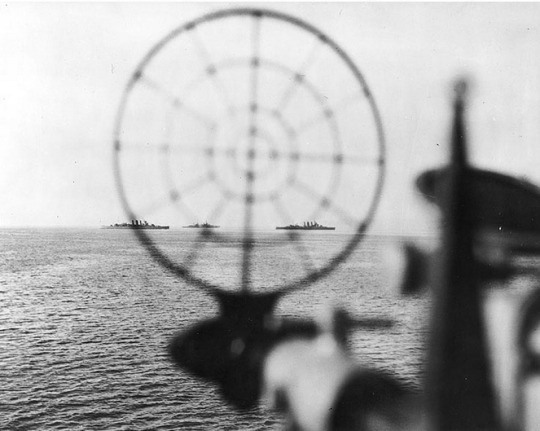
Heavy cruisers HMAS Shropshire and HMAS Australia, and an unidentified US heavy cruiser, seen through the gun sight of light cruiser USS Phoenix, off Leyte, 21 October 1944.
#Military#History#HMAS Shropshire#HMS Australia#USS Phoenix#Heavy cruiser#Light cruiser#Royal Australian Navy#US Navy#WWII#WW2#Pacific War#World War II
289 notes
·
View notes
Photo

HMAS Shropshire in Sydney on 9 September 1943.
#Royal Australian Navy#HMAS Shropshire#County-class#Sydney#World War 2#WW2#Pacific Theatre#Sydney Harbour#Heavy Cruiser
89 notes
·
View notes
Photo

Heavy cruiser HMS Shropshire in the spring of 1942, not long before she was transferred to the Royal Australian Navy to replace the sunken HMAS Canberra.
#Military#History#HMS Shropshire#HMAS Shropshire#Heavy cruiser#Royal Navy#Royal Australian Navy#WWII#WW2#World War II
60 notes
·
View notes